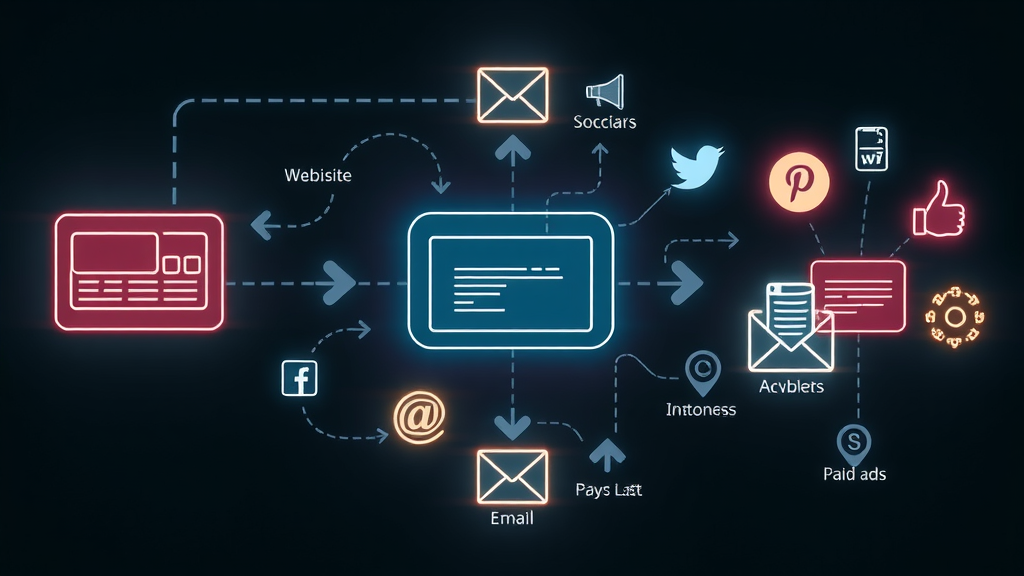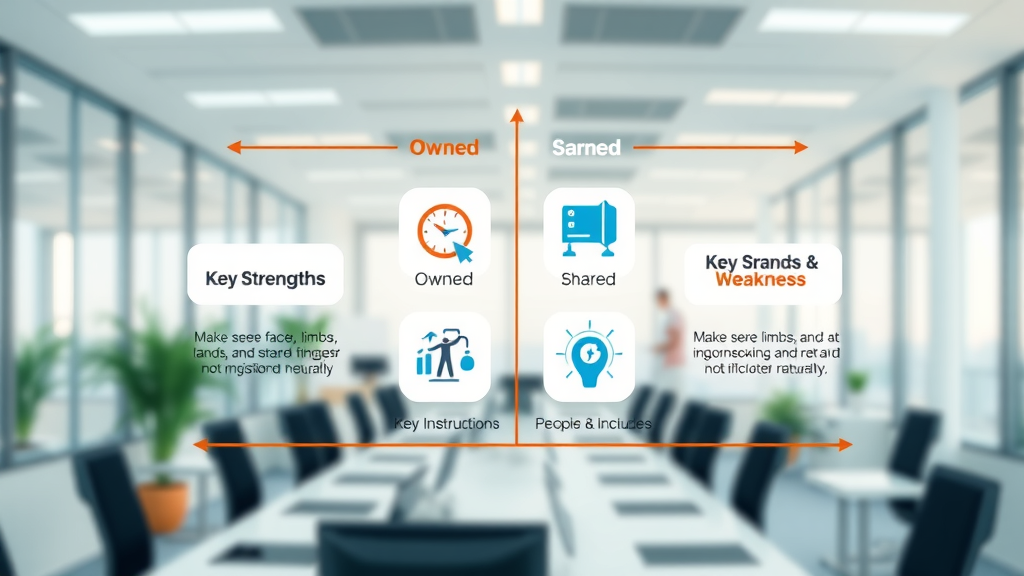Did you know brands utilizing multichannel content distribution achieve up to 250% higher engagement rates than those relying on a single channel? In today’s fast-paced digital landscape, being visible where your customers already spend their time is more crucial than ever. If your content marketing is only active on one platform, you’re missing out on massive brand visibility and valuable customer connections. In this comprehensive guide, you’ll discover how to master multichannel content distribution and elevate your channel strategy for outstanding returns.
Why Multichannel Content Distribution Is Essential in Modern Content Marketing
In the era of constant connectivity and short attention spans, relying on a single channel for content distribution is no longer enough. Audiences consume information on a range of distribution channels , including social media , email, websites, and mobile devices—each with distinct engagement patterns and preferences. Multichannel content distribution enables businesses to reach their target audience at multiple touchpoints, building both familiarity and trust.
For example, a marketing team launching a new product could create a blog post for SEO, promote it with a targeted Facebook ad, send an announcement to their email subscribers, and partner with influencers to expand reach on Instagram. Each channel amplifies the message, driving higher engagement than a single-channel approach. Today’s most successful brands treat content marketing as an ecosystem, orchestrating their messaging across multiple platforms and tailoring their approach for every end user . The result? More robust customer relationships, a competitive edge , and measurable business growth.

"Brands utilizing multichannel content distribution achieve up to 250% higher engagement rates than those relying on a single channel."
What You'll Gain by Optimizing Multichannel Content Distribution
- Understand multichannel content distribution fundamentals
- Identify key distribution channels and platforms
- Learn advanced distribution strategies for maximum brand visibility
- Explore robust tools and management systems for distributing content
- Analyze real-world case studies and data-driven insights
Defining Multichannel Content Distribution and Major Concepts
What is Multichannel Content Distribution?
Multichannel content distribution is the process of sharing your content marketing assets—like articles, videos, and infographics—across a variety of distribution channels such as social media , email, websites, and paid advertising. The aim is to maximize brand visibility by ensuring your piece of content reaches users where they spend their time, whether that's scrolling through Instagram, checking their email, or searching Google. By distributing content across multiple platforms, brands can increase their reach, foster deeper audience engagement, and build authority within their industry.
Every distribution channel serves a unique purpose—your company blog may boost SEO and provide value to existing customers, while a paid ad on Facebook can generate immediate interest from a new target market . Adopting a multiple channel approach allows your marketing team to connect with potential customers at different stages of their journey, ultimately improving the effectiveness of your content strategy and driving stronger business results.

The Evolution of Channel Distribution in Content Marketing
Channel distribution in content marketing has rapidly evolved over the past decade. Originally, brands would focus on a single medium, like print magazines or direct mail. As digital technology advanced, so did audience preferences. Today, a successful distribution strategy leverages both online and offline methods, from engaging blog posts and social media activity to podcasts, webinars, and even in-person events—forming what is now recognized as a robust multichannel content approach.
The rise of mobile devices and social networks has further accelerated the shift toward distributing content across multiple platforms . Not only does this expansion increase the likelihood of touching your target audience at just the right moment, but it also enables personalization, delivering the right message through the right distribution channels to improve the customer experience and foster brand loyalty.
Multichannel Content Versus Omnichannel Content: Understanding the Difference
Many marketers use “multichannel” and “omnichannel” interchangeably, but there are important distinctions. Multichannel content distribution refers to spreading content across several independent channels, optimizing for each one separately. For example, your email newsletter and your Instagram posts might share the same promotion, but they function independently. In contrast, omnichannel content aims for a fully integrated experience where every channel interacts seamlessly—ensuring that a customer who clicks an email and then visits your website experiences consistent messaging and personalization.
While omnichannel distribution is ideal, it requires significant investment and integration. For most businesses, starting with a solid multichannel content strategy delivers great results, providing broad reach and stronger brand visibility with more manageable resources. The key is to harmonize your content creation and distribution strategies , aligning them with your brand’s unique voice and the preferences of your target audience .
Understanding Channel Distribution and Content Distribution Strategies
Core Distribution Channel Types for Multichannel Content Distribution
Before building an effective distribution strategy , it’s vital to understand the types of distribution channels available for multichannel content distribution . The core channels fall into four categories: owned, earned, paid, and shared. Each offers distinct strengths and weaknesses that should guide your channel strategy . Owned channels —like your website and email list—grant control and allow personalized communication with your end user , but their reach is limited to existing subscribers. Earned channels , such as media mentions or influencer shoutouts, provide credibility and greater exposure, though they can be inconsistent and challenging to secure regularly.
Paid channels include social ads, sponsored articles, and display advertising. While these offer targeted, scalable exposure and can boost your marketing effort quickly, they may be more costly and risk advertising fatigue if not managed well. Shared channels —notably social media —allow rapid distribution and viral potential but are subject to platform algorithm changes, creating unpredictability. The most resilient content marketing plans diversify across all four, making sure distribution strategies tap into each channel’s unique advantages for more powerful audience engagement.

Structuring a Powerful Channel Distribution Strategy
Designing an effective channel distribution strategy for multichannel content starts by defining business objectives and understanding where your target audience consumes content. Evaluate the role of each channel—owned, earned, paid, and shared—against your goals. Establish clear rules for content creation (such as style and formatting guidelines) to maintain consistency and voice across all distribution channels .
Furthermore, integrate feedback mechanisms and analytics to measure the performance of each channel, identifying which content distribution tactics drive the strongest engagement, lead generation, or sales lifts. Flexibility is essential: as audience behaviors and algorithms evolve, so must your distribution strategy , ensuring continuous improvement and growth. Collaborate across departments to unify your marketing team around shared goals and encourage creativity in testing new platforms and formats.
| Distribution Channel | Primary Use | Strengths | Weaknesses |
|---|---|---|---|
| Owned (Website, Blog, Email) | Direct audience engagement | Control, credibility | Reach limited to subscribers |
| Earned (Press, Mentions, Shares) | Brand amplification | Trust, wider reach | Harder to secure regularly |
| Paid (Ads, Sponsorships) | Accelerated visibility | Targeted, scalable | Costly, ad fatigue risk |
| Shared (Social Media) | Community building | Viral potential | Platform algorithm dependency |
Developing a Multichannel Content Distribution Strategy for Multiple Channels
Mapping Your Target Audience for Effective Content Distribution
The foundation of successful multichannel content distribution lies in a thorough understanding of your target audience . Analyze demographics, preferences, pain points, and the types of digital marketing content they interact with most across different distribution channels . Create audience personas to guide content creation , ensuring every blog post, video, or ad is tailored to your desired end user and their preferred consumption styles.
Strategic audience mapping doesn’t stop at personas. Examine customer journeys to pinpoint when, where, and how your audience engages with various platforms—be it via desktop, mobile devices , or even online and offline events. Use these insights to inform your distribution strategy , allocating resources effectively and ensuring every channel aligns with the needs and habits of your potential customer .

Integrating Social Media, Digital Marketing, and Content Creation
Integrating social media , digital marketing , and content creation is paramount for effective channel distribution . Start by ensuring your marketing team collaborates across departments—social, SEO, email, and creative—to create a cohesive plan. Use a combination of organic posts, paid social ads, influencer partnerships, and interactive content to reach your target market on every relevant platform.
Consistent cross-channel messaging supports stronger brand visibility . Repurpose core assets: turn an in-depth blog post into a video snippet, an infographic for Pinterest, and a series of micro-content posts for Twitter or Instagram Stories. This strategy enables efficient content distribution at scale and keeps the customer experience consistent across all multiple channels . Your goal is not just to publish content everywhere, but to be everywhere that matters to your audience with messages tailored to each platform’s unique strengths.
Aligning Your Distribution Channels With Your Content Strategy
For optimal results, your distribution channels must serve the overarching content strategy . Review your business’s goals, from thought leadership to lead generation or customer loyalty, and identify which channels best support these objectives. If your aim is building thought leadership, prioritize owned channels such as a blog post series and LinkedIn articles. To reach a younger demographic, shift focus toward visually-driven social media platforms like TikTok or Instagram.
Build editorial calendars that map content topics and formats to specific channels and audience segments. Maintain flexibility to test new channel opportunities that align with your target audience and adapt your distribution strategy as trends and preferences evolve. This approach ensures your content marketing efforts deliver maximum impact and ROI.
Selecting Management Systems for Channel Distribution
Managing content distribution across multiple channels can get overwhelming without the right tools. Selecting an effective management system is essential for orchestrating publishing schedules, monitoring analytics, and ensuring content remains consistent across platforms. Look for systems that support streamlined workflow for posting, automation for recurring tasks, and integration with leading analytics tools to track audience reactions in real-time.
Popular options include comprehensive suites like HubSpot, Sprout Social, or Buffer, which offer publishing, monitoring, and reporting capabilities in a single dashboard. These management systems not only simplify the process for your team but also improve agility—making it easy to respond to timely events or pivot your channel strategy based on performance metrics. Choosing the right management system lays the foundation for a scalable, results-driven channel distribution strategy .
"A strong multichannel distribution strategy transforms your brand's reach from linear to exponential."
Implementing and Optimizing Distribution Strategies Across Multiple Platforms
Step-by-Step Guide to Multichannel Content Distribution
- Audit existing distribution channels and content assets
- Identify high-impact channels for your target audience
- Develop a content calendar for distribution
- Tailor content to the unique requirements of each channel
- Measure and iterate based on analytics
Effective multichannel content distribution begins with a clear understanding of your current assets and where they perform best. Conduct a full audit of existing channels, noting which ones deliver the strongest results (such as most engaged users, biggest leads, or highest conversions). Next, select only those distribution channels that align with your target audience and business goals, focusing your efforts for maximum efficiency.
With your channels prioritized, develop a detailed content calendar mapping out which piece of content goes where and when. Customize content formatting, messaging, and calls-to-action for each platform—recognizing that what works on Twitter won’t always connect on LinkedIn or in your email newsletter. Finally, leverage analytics to track results, doubling down on what works and iterating as audiences and algorithms change. Following this process ensures a visible, responsive, and high-ROI channel distribution strategy .
Utilizing Distribution Tools and Management Systems
Today’s marketing team relies on powerful management systems and automation tools to distribute and track content across multiple platforms . Solutions like Hootsuite, HubSpot, and Airtable centralize workflows, allowing unprecedented visibility into performance and streamlined adjustments. Key features to look for include scheduling capabilities, content approval workflows, cross-platform publishing, and advanced analytics dashboards that illustrate engagement, click-throughs, and lead generation statistics in real-time.
Automation ensures your marketing effort remains consistent, while analytics features help optimize for what resonates best. Tools that integrate with customer relationship software or advertising platforms can provide a holistic view of the customer journey—connecting channel distribution efforts directly to conversions and revenue outcomes. Selecting robust tools positions your brand for sustained success as you grow your presence across the digital landscape.

Enhancing Brand Visibility Through Multichannel Content
Comprehensive multichannel content distribution is the most effective way to ensure lasting brand visibility in a crowded marketplace. By reaching audiences at multiple touchpoints, your content marketing strategies create familiarity, promote trust, and guide customers from discovery to action. Well-synchronized distribution channels let your message be seen—not missed—no matter where your prospective customers spend time online or offline.
To maximize visibility, diversify content formats for each platform (videos for social media , blog posts for SEO, infographics for Pinterest, etc.), optimize headlines and visuals for platform requirements, and maintain consistent branding and messaging. Brands that embrace a strategic, data-driven approach to distributing content reap bigger audiences, increased engagement, and richer customer relationships over both the short and long term.
Measuring Content Marketing ROI Across Multiple Channels
Tracking success is a vital component of any channel strategy —especially when working with multiple channels . Establish clear metrics tied to each distribution channel , whether it’s audience reach, engagement rate, website traffic, or lead quality. Use tools like Google Analytics, platform-specific dashboards, and CRM integrations to measure performance. Compare results over time to understand which effort is driving the greatest returns, and which tactics need rethinking or replacement.
Advanced management systems make it easy to compile cross-channel reports, highlighting the relationships between various digital marketing efforts and ultimate ROI. By making data-driven refinements, brands can faithfully attribute each win back to a specific marketing effort —ensuring continual optimization and improved return on investment for every piece of content you publish.
Overcoming Common Challenges in Multichannel Content Distribution

Avoiding Message Dilution Across Distribution Channels
With content being published across multiple channels , the risk of message dilution is real. Ensuring that the core message remains consistent while adapting to the style, tone, and expectations of each platform is key. Start with clear messaging guidelines for all content creation . Empower your marketing team to localize and personalize copy and visuals—while aligning every asset to your master brand narrative.
It’s also important to establish routine reviews and feedback loops—for example, assign a content editor or brand manager to verify branded messaging before any distribution strategy rollouts. These efforts help preserve the value of your message and protect your brand visibility on every distribution channel .
Managing Content Consistency and Channel Strategy
Content consistency is foundational for trustworthy content marketing . Maintaining a content calendar, deploying digital asset management tools, and scheduling regular cross-team alignment meetings are practical steps that keep everyone on the same page. As priorities shift and channels evolve, make it a habit to revisit and revise your channel strategy based on the latest feedback and performance data.
Cross-functional collaboration improves workflow and ensures no piece of content is published in isolation. The more organized your processes, the stronger your holistic multichannel content presentation—leading to a seamless customer experience and better overall business outcomes.
Tracking Performance and Optimizing Distribution Strategy
Measuring the effectiveness of distribution strategies requires more than just tallying likes or shares. Deep-dive into channel-by-channel analytics, review engagement across different audience segments, and monitor real-time KPIs like website traffic, conversions, and revenue. Periodic updates to your content calendar, A/B tests for messaging, and regular channel performance reviews will ensure your channel distribution strategy stays agile and ahead of trends.
Brands that invest in tracking and optimizing are rewarded with sharper insights into what motivates their target audience . This enables more efficient allocation of resources and improved ROI across every distribution channel —building a data-driven culture that thrives in today’s digital landscape .
"Brands that master content distribution build lasting authority and customer relationships."
Case Studies: Successes with Multichannel Content Distribution
B2B Brand Visibility Through Targeted Content Distribution
A tech startup aiming for rapid growth implemented a multichannel content distribution plan targeting business decision makers. Content assets included insightful blog posts on industry trends, whitepapers distributed via LinkedIn campaigns, and nurturing email sequences to warm leads. By leveraging both owned channels (website/blog) and shared channels ( social media ), as well as paid ads on targeted platforms, the brand experienced a 300% increase in qualified leads within six months. Integration and consistent messaging across all touchpoints resulted in higher engagement from their exact target market .
Strategic content creation and agile channel management allowed the company to quickly adapt to audience sentiment and timely industry topics, strengthening their positioning as thought leaders on multiple platforms .
Retail Success: Integration of Digital Marketing and Social Media Channels
An e-commerce brand sought to double their order volume through a more robust content distribution approach. They developed shoppable Instagram stories, partnered with influencers for YouTube product reviews, and ran Facebook ad campaigns tied to blog post guides. Simultaneous investment in email marketing and SEO improved organic discovery of their products, while UGC campaigns fueled their social media presence.
The result: a 2x increase in order volume and higher repeat purchase rates, thanks to a fully integrated distribution strategy that met customers where they already spent time.

Nonprofit Storytelling Using Multiple Platforms
A leading nonprofit looked to boost awareness and donation rates by modernizing its channel distribution . Integrating emotive video storytelling on YouTube and Facebook, releasing blog updates, and running collaborative partnerships via podcasts and PR outreach expanded their message. Real-time response to audience engagement allowed campaign pivots and dynamic updates.
Within a quarter, the nonprofit saw a 20% uptick in donations and far-reaching awareness spikes—not just for fundraising, but for volunteering and partnering as well. Their management system provided campaign analytics to show where every marketing effort paid off most.
| Brand | Goal | Distribution Channels Used | Results |
|---|---|---|---|
| Tech Startup | Lead generation | SEO, social media, email | 300% increase in leads |
| E-commerce | Conversion | Influencers, paid ads, blog | 2x order volume |
| Nonprofit | Awareness | Video content, PR, partnerships | 20% uptick in donations |
Frequently Asked Questions About Multichannel Content Distribution

What is a multichannel distribution?
Multichannel distribution is the process of sharing and promoting your brand’s content or products across several independent channels—such as your website, email, social media , paid ads, and public relations. By relying on multiple platforms, you reach a broader target audience , boost brand visibility , and drive more touchpoints with potential customers.
What are the three 3 platform categories for content distribution?
The three primary categories for content distribution are: owned platforms (content you fully control, like your website and email newsletters), earned platforms (media coverage, mentions, and shares generated through third parties), and paid platforms (advertising channels such as paid social, search ads, and sponsored content). Some models also include a fourth category— shared platforms , namely social networks and collaborative environments.
What is multichannel content?
Multichannel content refers to any marketing or informational asset—blogs, videos, infographics, ads, or newsletters—created for and distributed through more than one channel or platform. It’s a strategy designed to broaden your reach, connect with diverse target audience segments, and reinforce messaging for better engagement and improved customer experience .
What are the four types of distribution channels?
The four main types are: Owned channels (your website, blog, and email), Earned channels (press coverage, influencer mentions, organic shares), Paid channels (ads, sponsorships, promoted content), and Shared channels (social media communities). Each serves a unique role in a multichannel content distribution plan, building reach and resonance across various audience groups.
Best Practices and Pro Tips for Multichannel Content Distribution
- Diversify your content formats for each channel
- Leverage automation tools to streamline management
- Continuously audit and update your channel strategy
- Focus on analytics to guide distribution strategy
- Integrate user feedback to refine content distribution
"Effective multichannel content distribution isn't about being everywhere—it’s about being everywhere that matters for your audience."
Next Steps for Maximizing Multichannel Content Distribution Results
Ready to grow your business? Book your free Marketing Strategy Session at imodagency1.com or call 562-620-7576 now and conquer multichannel content distribution like the experts.
To deepen your understanding of multichannel content distribution, consider exploring the following resources:
- “Multichannel Content Distribution: Strategies to Increase Reach and Engagement” ( velarastrategies.com )
This article delves into the importance of distributing content across various platforms to enhance audience engagement and brand visibility.
- “Mastering Multi-Channel Content Distribution for Maximum Reach” ( marketingsalesninja.com )
This resource provides insights into effective tools and best practices for implementing a successful multichannel content distribution strategy.
By reviewing these materials, you’ll gain practical strategies and tools to optimize your content distribution efforts across multiple channels.
 Add Row
Add Row  Add
Add 




Write A Comment